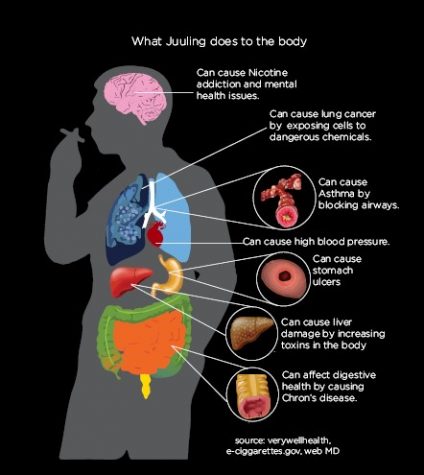story by Anna Mullins | photography by Alexandra Fernholz | infographic by Gracie Estep
*denotes name change
The room is dark. The only light comes from string lights lying across the floor, basking the room in a weak ambient glow. Upbeat music plays in the background from the other side of the curtain. Nine teens stand in a circle talking about the most recent school drama. The only teen facing the door is the the one with the most important job—the unofficial lookout—who is charged with making sure no adult catches the teens passing around a Juul.
Juul is a flash-drive shaped e-cigarette that came into existence in 2015 when Juul Labs Inc. began manufacturing the Juul e-cigarette and pods. According to the Surgeon General Jerome Adams, the JUUL has recently become popular among teens because of its minimal smoke, low odor and small size, making it easy to conceal at school in a pencil pouch or shirt sleeve.
Sitting in class *Rachel, an East junior, feels a buzz come from her pocket. Looking away from the teacher, she checks her phone and realizes it is a text from one of her friends asking her to come to the bathroom and bring her juul. Her friend was having an anxiety attack and said she needed to hit Rachel’s juul to calm herself down.
“My friend group has two kids out of seven who have [juuls],” Rachel says. “And the other kids hit it, they’re always like, ‘Hey, can I borrow it?’ I’ve been texted in the middle of class ‘Hey, can you meet in the bathroom? Can I hit your juul? I really need it because my anxiety is going off.’”
Rachel herself recognizes that there are other ways to deal with anxiety and stress that are less damaging to her health than nicotine. According to the Surgeon General one juul pod has the same amount of nicotine as 20 cigarettes, or one full pack of cigarettes.
Jennifer Folkenroth is the National Senior Director for the tobacco program at the American Lung Association (ALA), which researches how nicotine affects the body. Folkenroth says that nicotine, an addictive chemical in JUULs and cigarettes, really affects the neurotransmitters to give a pleasure reward feeling to the brain.
“A lot of teens are using it behaviorally, as a stress management tool,” Folkenroth tells Spark. “They have the release of dopamine in the brain, which helps [them] to relax, stimulates [them], and for many people, just makes them feel good.”
This calming effect can come at a high price. According to a National Institute on Drug Abuse article “Is Nicotine Addictive,” when nicotine is inhaled, it causes a surge of endorphins in the reward center of the brain, delivering a brief euphoria to the user. Like other drugs of abuse, such as cocaine and heroin, the nicotine increases levels of dopamine, which reinforces addiction behavior. Nicotine reaches the brain within 10 seconds of inhalation and the brief “high” dissipates quickly. Repeat exposure to nicotine alters the receptors’ sensitivity to dopamine.
79 percent of East students surveyed said they had seen someone juuling at school.
“When you depend on certain drugs, the receptors that have to bind [to] those chemicals continue to be used up,” East Honors Anatomy teacher Julie Deak says. “In order to get that same calming sensation, a person would have to use nicotine more and more. It’s a never-ending cycle.”
In ninth-grade, Rachel’s friend group became interested in e-cigarettes. They were intrigued by how cool the technology appeared, how it allowed them to smoke vapor, and how they could do “cool tricks.” That’s when a senior friend introduced her to juuling.
“I had a friend of mine who was asking me: ‘Hey, do you want one? Or have you ever thought about wanting one?’ And I was like, you know what, might as well try it out,” Rachel says. “And I bought one.”
Rachel and her friends had become part of the 3.04 million youth who use e-cigarettes in high school. According to the 2011-2018 National Youth Tobacco Survey (NYTS), e-cigarette use among high school students increased by 78 percent between 2017 and 2018. This dramatic increase prompted the Surgeon General to label youth e-cigarette use an epidemic in the United States.
The JUUL was created as a cessation option to help adults who have become addicted to cigarettes, it has the potential to reduce tobacco-related death and disease. However, studies with teens are starting to show that these devices could be doing the exact opposite. The concern is that juuling is becoming a gateway to cigarette smoking for the teen population. Behavioral scientist at RAND Corporation Michael Dunbar conducts studies on these topics to determine their validity.
“We know from overall estimates across a range of studies that have looked at this issue that young people who start using e-cigarettes are about four times more likely than their peers who don’t use them to smoke cigarettes in the future,” Dunbar tells Spark.
Since e-cigarettes are not ignited, do not have a lasting smell, look like a flash-drive, and taste like common fruits and candies, they are assumed to be safe.
“I think a major area of concern is that if e-cigarettes are framed as being less harmful to health than cigarettes, that can lead people to assume that because they’re ‘safer’ in some respects, that means that they’re safe to use.” Dunbar says. “That’s not the case, particularly when it comes to young people.”
*Monica was on her way to grab a notebook for one of her classes when she decided to stop at the bathroom. Immediately when she walked in, a curious smell hit her nose and she noticed six pairs of feet in a single stall. There were empty juul pods littering the ground and smoke was hanging in the air. Even though this wasn’t the first time she had witnessed this, Monica decided that she didn’t need to go to the bathroom anymore and continued on to class.
According to the Truth Initiative, 47 percent of high school and middle school teachers and administrators polled didn’t recognize a photo of a JUUL device, despite rising teen use. The East administration has noticed the rise in teen use and is taking action to help quell the popularity of e-cigarettes among the school population. They are putting into place strategies to combat juuling, but chose not to discuss them publicly.
“There is no magic wand we can wave to stop it from happening,” East Principal Suzanna Davis says. “But we’re going to continue to discuss what we can do within our environment to cut down on [juuling], both from a health factor for students, as well as a safety factor.”
The goal for the policies is not to exact punishment on those who are juuling, but to provide information to the students about the dangers and why is is not good for their health.
“The ultimate goal of having conversations with the student is behavior modification,” Davis says. “I don’t want to punish a student because they’re juuling, I want to give them the impetus to make change in their life because it’s dangerous.”
Since e-cigarettes are relatively new, long term effects have not yet been identified, but many short term effects have been researched. The Food and Drug Administration’s (FDA) current research priorities include understanding cardiovascular and respiratory health effects caused by e-cigarettes.

In a partnership with the National Institute of Health (NIH), Tobacco Centers of Regulatory Science grants were awarded to support research on the impact of flavors, short and long-term effects of e-cigarette products, and changes in cell function upon exposure to vapor.
In a NIH funded study by the University of Rochester Medical Center, vapors released by juuls were found to cause stress in the cells in the gums, that can in turn cause oral diseases. The study also showed that e-liquid with flavoring made the damage worse. One of the hazardous chemicals present in the vapor—nicotine—is a known contributor to gum disease, and can cause permanent damage to the developing adolescent brain.
“Nicotine affects the development of the prefrontal cortex of the brain, and this applies directly to teens,” Deak says. “Nicotine addiction can affect your decision making processes, and it also [delays] your emotional development.”
The chemicals inside of the pods include diacetyl, a chemical that has been linked to lung disease; benzene, which can be found in car exhaust; and ultra-fine flavoring particles which can cause coughing, especially for those with asthma.
“E-cigarettes also contain acrolein, a herbicide that primarily is used to kill weeds,” Folkenroth says. “However, we know that it can cause acute lung injury, Chronic Obstructive Pulmonary Disease (COPD), and may even cause asthma and lung cancer.”
Different flavor pods are designed to mimic the taste of popular candies and are placed in convenience stores near the candy at the registers. The packaging of the pods is also very similar to the candies that they mimic.
“Mango is a good one,” Rachel says. “It didn’t taste like a mango, but it also was fruity enough to taste good. It tastes like candy, it’s addictive.”
With more than two-thirds of teens using flavored pods, according to the NYTS study, many experts believe that the different flavors are targeting children, even though it is illegal for them to use the e-cigarettes.
“Research has shown a strong connection between the fruit flavors and their way of really appealing to our youth,” Folkenroth says. “If you take a look at [the flavors, like] Fruity Pebbles, bubble gum, cappuccino, some of those flavors on the market are mostly purchased by our youth.”
The FDA is creating a new policy surrounding e-cigarette use, as well as restricting the availability of flavor pods. Part of this policy is restricting pods from being in places where kids can see them.
“We know that exposure to ads in convenience stores and other retail settings is a big issue,” Dunbar tells Spark. “We also know that young people who are exposed to those types of ads are more susceptible to start using e-cigarettes in the future.”
While high schools have seen the most drastic rise in e-cigarette use, middle schoolers have also taken to vaping. According to the same NYTS survey, middle school use of e-cigarettes has increased by 48 percent between 2017-2018.
Hopewell Junior (HJS) Principal Jeff Rouff has noticed the rise as middle schoolers experiment with independence for the first time. He has begun to take action through Hopewell’s weekly newsletters to parents, reminding them to have conversations with their kids about the dangers of juuling.
“[I have done this] not only as a principal, but also as a father of two daughters, and I’ve had to have these tough conversations with my daughters,” Rouff says. “There’s this mindset that it’s okay, that it’s a safe alternative. And that is going to be the big battle of juuling with kids. It is getting them to realize that this is not a safe alternative.”
HJS also decided to take action by expanding their curriculum. The mandatory eighth-grade health class has added e-cigarettes into the tobacco unit, and the school resource officer talks about vaping during the drug unit.
“You need to have the facts before you try anything that could potentially harm your body,” HJS health teacher Lori Jones says. “That isn’t specifically for juuling either, that is for any kind of drug, alcohol, [or] tobacco.”
23 percent of East students surveyed confirmed they Juul.
Rachel has always been anti-smoking, as her parents are smokers, and she is familiar with the negative health effects. When Rachel started juuling, she was unaware of the hazards and possible nicotine addiction. Once she realized all of the harmful effects that juuling could have on her body, she quit. She has not juuled since she got rid of her e-cigarette two months ago.
Because of this epidemic many organizations have come out with options for teens who are looking to quit vaping or are trying to combat a smoking addiction. The American Lung Association (ALA) has a program that aims to help teens stop smoking.
“American Lung Association’s ‘Not on Tobacco’ program is a voluntary smoking cessation program that is inclusive of e-cigarette users,” Folkenroth says. “That’s specifically for teens ages 14 to 19. It’s a 10 week program where participants really learn to identify their reasons for smoking, as well as painting healthy alternatives to tobacco use.”
The first teen e-cigarette focused program “This is Quitting,” was established by the Truth Initiative, with input from teens and young adults. It is a mobile app and companion text message program that offers motivational messages and alternative options to distract from vaping, as well as information on nicotine replacement therapy. Realizing quitting can be both challenging and isolating, a support function is included that allows teens to text the word “Crave” to immediately receive positive messaging.
“One of our messages is, ‘You may be tempted to juul when other people are, but find something else to do with your hands like a little toy, a key chain, take pictures on your phone, tap on Snapchat filters, whatever it takes to not juul in that moment,’” Truth Initiative Representative Megan Jacobs tells Spark. “We try to give actual suggestions that give people something specific that they can do.”
Many organizations have made it their mission to inform teens of the dangers of using e-cigarettes. They also continue to research what the long-term effects of these devices are, so that they can continue to inform and educate.
“I know that my lungs weren’t too happy because all the chemicals go straight to your lungs and it damages them,” Rachel says. “I quit because I realized that when you start at a young age, you’re going to tend to end up doing it when you get older and it’ll be more of an addiction to stop.”




































































































